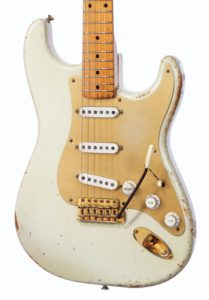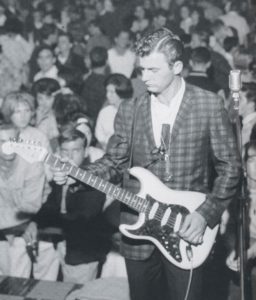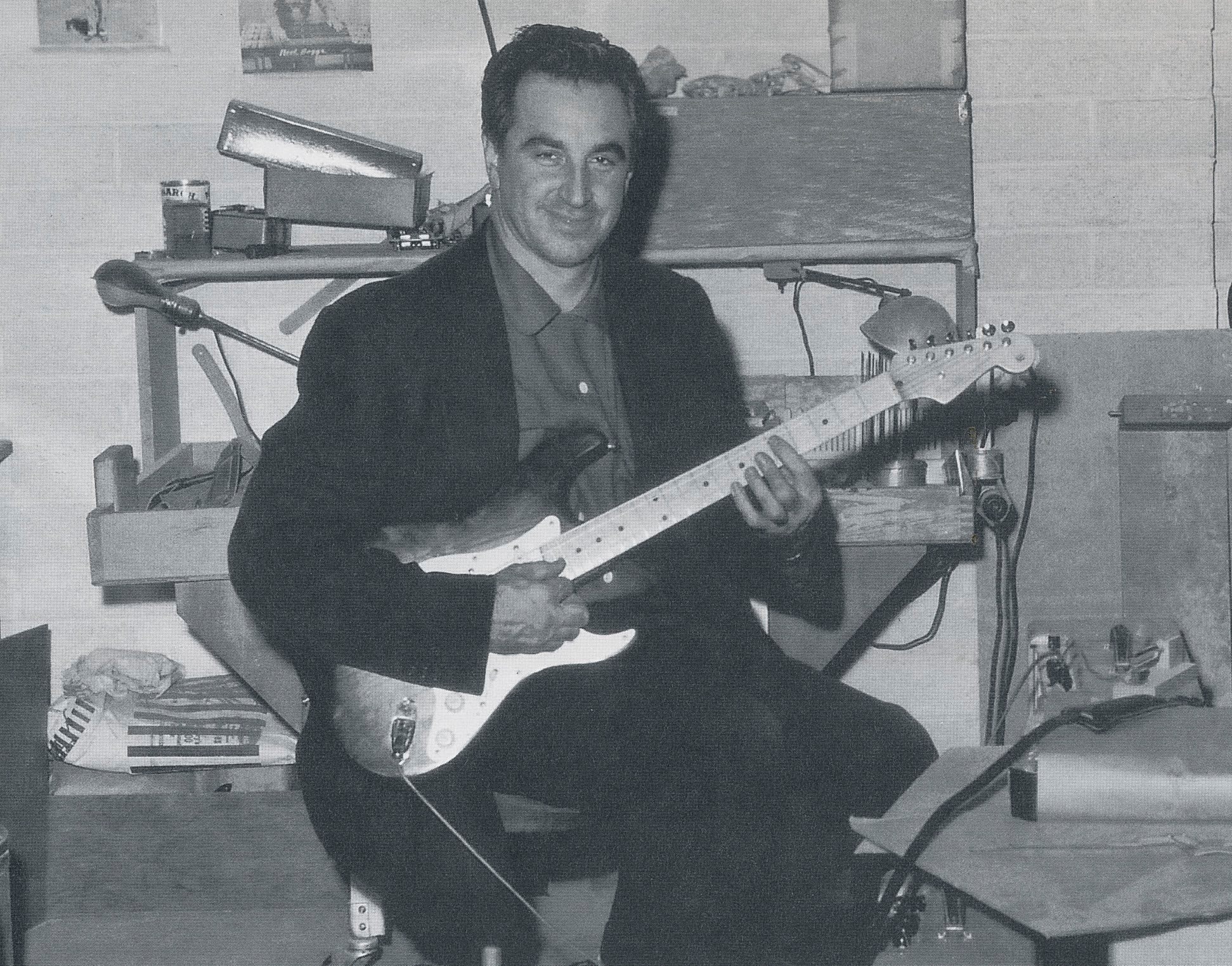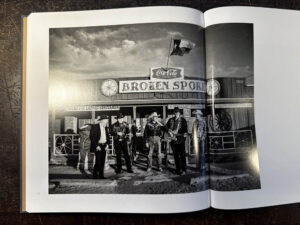In the history of the Fender Stratocaster, a little-known Italian Country musician from California named Rex Gallion holds the distinction of being the man who suggested to Leo Fender in 1953 that the new instrument he was designing could have body contours for comfort in playing, unlike his earlier squared-off solidbody guitar, the Telecaster. Anyone who has ever played a Fender guitar or bass with “custom contours” can thank Rex Gallion for the idea.
Rex and his brother Von played in a western group called The Gallion Brothers, and Rex married a singer named Ginny Greer. As “Ginny and the Gallions,” they played all around the West Coast as a supper club and casino act.
Leo Fender gave Rex Gallion a blonde Stratocaster with gold pickguard and gold hardware, serial Number 001 (it wasn’t the first one ever made, but it did have that unique serial number on the neck plate—added later for unknown reasons). Von Gallion was gifted a similarly unique 1955 Fender Precision Bass, blonde with gold pickguard and gold hardware, with custom contours—a one-off “custom shop” bass. (My interest in the Rex Gallion/Gallion Brothers story began when I found a custom-made reissue of the Von Gallion blonde/gold P-Bass on Craigslist and started researching the story)
True guitar geeks will note that David Gilmour of Pink Floyd wound up with Rex Gallion’s #001 Strat, and it became as famous for being Gilmour’s guitar as it was for being a spectacular early deluxe example of a Stratocaster. Gilmour eventually sold Rex Gallion’s Strat at an auction in 2019 and sold for a whopping $1,815,000—almost two million dollars.
This is the Fender Stratocaster obscure trivia that is well-known to the guitar geeks out there—David Gilmour, Leo Fender, custom contours….it’s been written about and discussed a thousand times. What I don’t think any guitar geek has ever researched, though, is Rex Gallion as a PLAYER.
Because I was interested in the history of the blonde/gold Strat and P-Bass, I kept digging for more info on Rex and Von Gallion. I found out that Rex was one of those classic old-timer musicians who played mandolin, banjo, accordion and guitar. Ginny and the Gallions worked in the same circles as lots of country and rockabilly heroes—one version of the group in Reno even had Marshall Lytle from Bill Haley’s Comets on bass! They spent a lot of time in Southern California, appearing on Town Hall Party and other Los Angeles-area country music television shows. During the 1950s, Rex was one of those guys, like Jimmy Bryant and Bill Carson, who hung around the Fender Guitar factory all the time, jamming and offering player’s suggestions on how Leo might improve his instruments.

I knew that Ginny Greer made records with the Gallions, and most of the ones I had heard were predictable easy listening Las Vegas lounge type music. But then I recently found this 1963 album “The Two Sides of Ginny and the Gallions” on Downey Records. Half of the record is vocals by Ginny Greer. The other half, however, are guitar instrumentals by Rex Gallion.
Midway through Rex’s version of “Hava Nagila,” the song that leads off the instrumental side of the album, my head started spinning. Here was an Italian country lounge musician who played mandolin, heavily involved with Fender guitars in the 1950s and the development of the Stratocaster, DOUBLE-PICKING ON A STRATOCASTER….I couldn’t help but think, “holy crap, is this guy another link in the evolution of surf music, and Dick Dale’s style?”
Lots of us know that Dick Dale started out as a country musician, playing a Magnatone guitar and appearing occasionally on the Town Hall Party television show (it was a rotund comedian on Town Hall Party named “Texas Tiny” who told Richard Monsour he should change his stage name to “Dick Dale”—true fact).
Dick also took guitar lessons from Larry Collins of the Collins Kids, and an undeniable influence of Dick Dale’s sound was the fast country pickin’ that Joe Maphis and Larry Collins did on the television show. There isn’t a huge leap from songs like “Flyin’ Fingers” or Larry’s version of “Guitar Boogie” to what Dick Dale started doing a few years later with songs like “Surf Beat” and “Misirlou.”
Rex was one of those classic old-timer musicians who played mandolin, banjo, accordion and guitar. Ginny and the Gallions worked in the same circles as lots of country and rockabilly heroes—one version of the group in Reno even had Marshall Lytle from Bill Haley’s Comets on bass!
Well, except for one thing—the double picking. Joe Maphis and Larry Collins didn’t double-pick, they played their fast country guitar licks in the standard picking type of way. I always wondered where Dick Dale got the inspiration to play his style with double-picking (the quick burst of picking notes you hear at the beginning of “Misirlou,” in case you’re unfamiliar with the term).
And here, new to my ears, was Rex Gallion. It made sense that he was an Italian mandolin player, that style of mandolin playing was pure double-picking, what mandolin players called “staccato picking.” But on this record, Rex Gallion was doing it….on a Stratocaster. The similarity between what he was doing and what Dick Dale did was too great to ignore.

Now, this Ginny and the Gallions recording of “Hava Nagila” came out in 1963, the same year that Dick Dale’s recording of the same song was released. And Dick first started with his double-picking in 1962 with his version of “Misirlou.” I haven’t (yet) found any recordings of Rex Gallion that predate Dick Dale showing him using the technique. But….he was around in the mid-1950’s, playing that style on guitar. Dick Dale would have met Rex Gallion at the Fender offices, or seen him on a country music show.
It would certainly make sense that Dick Dale got his technique from seeing Joe Maphis and Larry Collins blazing away on the Town Hall Party show, and absorbing the double-picking “staccato” picking technique from an Italian mandolin player country musician who hung around Fender Guitars and was a part of the Stratocaster’s birth.
We all know that Dick loved to tell grandiose stories, like the one where “he got his sound by surfing big waves and feeling the power of surfing when he played the guitar like that.” Well….yeah, maybe. But it would make a lot more sense if he got that style listening to Larry Collins and Joe Maphis and….Rex Gallion. To me, when I heard this recording, it all clicked into place. Of course! A mandolin player plays in that double-picking style. A mandolin player who hung around Leo Fender’s office that played that double-picking style on a Stratocaster guitar? Yeah….for me, this was a “light bulb over the head” moment.
For those of you geeky enough to have read this whole thing, I hope you’ve enjoyed the deep-dive into this little corner of guitar and rock ‘n’ roll history. You don’t have to agree with me, and you don’t have to post your ten million comments of how Blind Leg Pete used two measures of double picking on his 1927 recording of “Ham Hocks and Cornbread.” I feel like there’s quite a bit of evidence here, but it’s all conjecture…just an educated opinion. This is just a little personal journey I took, and I think there’s something there worth putting your hand on your chin and saying “hmmmm!” Enjoy, you nerds!!
Just got some additional Info from the very knowledgeable Terry Foster: The 001 Stratocaster did not have the 001 serial number on it until much later, perhaps the 1970s. For some reason, somebody added that. It is a very early Stratocaster, however. In addition, the Von Gallion bass is a 55, not a 54.





